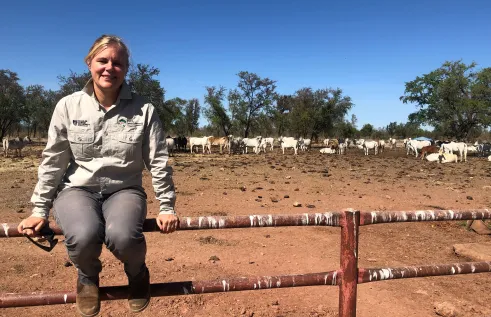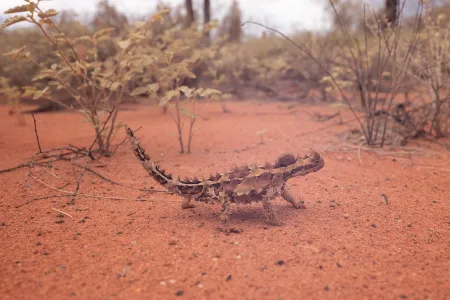News
School students inspire study into Central Australia’s infamous Thorny Devils
A Central Australian researcher from Charles Darwin University (CDU) is analysing the social behaviour and physiology of Australia’s Thorny Devil to answer unexplained questions about the iconic creature.
CDU researcher from Research Institute of Environment and Livelihoods, Dr Christine Schlesinger will seek to find out just how far and wide Thorny Devils, known as ngiyari to local Pitjantjatjara speakers, roam and why so many are spotted on roads.
As a part of her research, Dr Schlesinger will work with students from Nyangatjatjara College in Yulara near Uluṟu, park rangers and community members.
The project has just received $81,000 for over three years from the Herman Slade Foundation to help fund the project that will use observations, radio tracking and remote cameras in an investigation into the Thorny Devil’s habits and interactions in the harsh Central Australian environment.
"The research was conceived following questioning by two young Anangu women, students of Nyangatjatjara College, about why there were so many ngiyari on the roads around Uluṟu between their home and school,” Dr Schlesinger said.
“They are often seen on roads because that’s where people and the lizards cross paths. And they are much easier to see when they’re not camouflaged against the red sand. But we are not sure if they are on the roads by coincidence or for thermo-regulatory purposes.”
Uluṟu-Kata Tjuṯa National Park Manager Dianne Scopel said the engagement of Indigenous students from local Nyangatjatjara College provided the perfect opportunity to extend the classroom into the park.
“Ngiyara is a culturally significant species for Anangu and the research project allowed local students and elders the opportunity to engage with scientists and help inform the management and conservation of the species within the National Park,” Ms Scopel.
Nyangatjatjara College Principal Mike Tucker said the study was a great learning opportunity for the students.
“We are really pleased to develop this partnership with CDU and Uluṟu-Kata Tjuta National Park to give our students authentic experiences with western science and its processes while at the same time, connecting with the work of a range of other stakeholders,” Mr Tucker said.
Dr Schlesinger said ngiyari lived mostly in remote sandy deserts dominated by spinifex and don’t move far from their burrows except for a few months in Autumn and Spring each year. For these reasons, despite being widespread, ngiyari are rarely seen.
“These are remote areas, so surveying and studying movements, requires a little bit of creativity,” Dr Schlesinger said.
Dr Schlesinger said Nyangatjatjara College students would be a vital part of the research as they record and report on any ngiyari sightings, especially as they travel to and from school each day.
“As well as the students, we plan to enlist as many citizen scientists from the local community as possible to assist with the project and look out for thorny devils, and so far there has been lots of enthusiasm,” she said.
“The methods used, and data collected will be discussed and evaluated as part of the school curriculum.”
Related Articles

Where rubber meets the road: Old tyres are key to building tougher roads
Almost half of the Northern Territory’s worn-out tyres end up in landfills – with the rest exported interstate for recycling – but a study led by Charles Darwin University (CDU) is repurposing the discarded rubber to build stronger, sustainable roads that meet the NT’s unique needs.
Read more about Where rubber meets the road: Old tyres are key to building tougher roads
Social media subjecting Black women to radicalised digital policing
Influencers use oppression, manipulation and weaponisation to police Black women on social media, according to new research uncovering the entrenched nature of digital racism.
Read more about Social media subjecting Black women to radicalised digital policing
Moo-ving the boundaries: New research evaluates virtual fences for use on NT cattle stations
Cattle producers in Northern Australia face unique challenges when adapting tools like virtual fences on their properties, but new research from Charles Darwin University (CDU) is set to break down the barriers to this technology.
Read more about Moo-ving the boundaries: New research evaluates virtual fences for use on NT cattle stations
